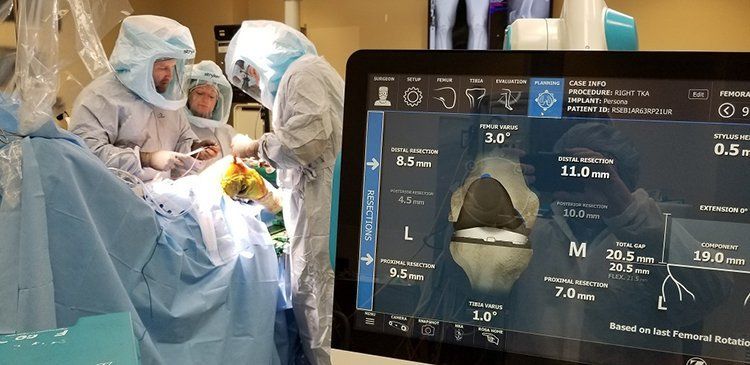Knee
Robotic Assisted Surgery
Knee replacement surgery is a highly effective procedure for patients suffering from debilitating knee pain due to osteoarthritis, trauma, or other joint disorders. Over the years, this surgery has improved significantly, with the development of robotic-assisted surgery bringing new precision and possibilities. Dr. Ryan du Sart has embraced this technology to enhance surgical outcomes for his patients, assisting to ensure optimal results and faster recovery times.
What is Robotic Assisted Surgery?
Robotic-assisted knee replacement combines robotic technology with the expertise of your orthopaedic surgeon, offering enhanced precision during the procedure. While Dr. du Sart is still in full control of the operation, the robotic system assists in bone preparation, implant positioning, and achieving precise alignment. This innovative approach leads to greater planning, customisation, and accuracy in complex knee surgeries.
Robot-assisted knee surgery has been steadily gaining traction in both Australia and internationally, and is now available at both Bunbury and Busselton for patients seeking advanced surgical options.
How Does Robotic Assisted Surgery Work?
The first step in robotic-assisted knee surgery involves pre-operative planning, where X-rays and virtual knee replacement technology are used. This process helps Dr. du Sart visualise how the bone cuts should be made and where to place the knee prostheses. This highly detailed plan allows for accurate, computer-assisted alignment and soft tissue balancing during surgery.
Once the pre-operative planning is complete, Dr. du Sart uses the robotic arm to guide the bone cuts and implant positioning. The technology enhances the precision of the procedure, ensuring better outcomes. While robotic assistance enhances the accuracy of bone cuts and positioning, all tasks such as skin incisions, exposing the knee, trialling the implant, and closing the incision are completed in the same way as conventional knee surgery.
What Kind of Implants Are Used in Robotic Knee Surgery?
The implants (prostheses) used in robotic-assisted surgery are the same as those used in conventional knee replacement surgery. However, the advantage of robotic technology is that it allows Dr. du Sart to plan the size, fit, and positioning of the implants based on your individual knee anatomy, ensuring a more personalised fit. This pre-operative planning is crucial for achieving the most natural alignment and functionality in the knee.


Advantages of Robotic Assisted Knee Surgery
Robotic-assisted knee replacement offers several distinct advantages over traditional techniques, including:
- Enhanced Accuracy: The robotic system enables highly precise bone cuts, improving the positioning of the prostheses.
- Reduced Surgical Errors: Robotic technology minimises the risk of errors that could result in inaccurate placement or alignment, ensuring better outcomes.
- 3D Knee Mapping: This technique allows for accurate pre-operative planning, which leads to better prosthesis fit and improved function.
- Soft Tissue Balancing: The robotic system allows for intra-operative collection of soft tissue data, helping to balance the knee joint and reduce post-operative complications.
These advantages contribute to more accurate surgeries and the potential for faster recovery times, as well as a better overall functional outcome.
Challenges and Limitations of Robotic Surgery
Despite the advantages, there are some challenges to robotic-assisted surgery:
- New Technology: As with any emerging technology, robotic-assisted knee surgery is relatively new and may not yet have long-term outcome data for all cases. However, early results have been promising, with studies such as Kayani and Haddad (2019) showing excellent early results for patients who have undergone robotic-assisted knee replacement.
- Training and Experience: Surgeons must undergo rigorous training to use robotic systems effectively, which ensures that patients receive the best care possible.
What Does the Future Hold for Robotic-Assisted Surgery?
The future of robotic knee surgery looks promising, with continuous improvements in technology and surgical techniques. Ongoing research and development are expected to refine the systems and offer even better outcomes for patients in the future.
Why Choose Dr. Ryan du Sart for Robotic Assisted Knee Surgery?
Dr. Ryan du Sart is a highly experienced orthopaedic surgeon who is skilled in both conventional knee replacement and robotic-assisted knee surgery. By utilising the latest in robotic technology, he is able to offer his patients a personalised approach to knee replacement, aimed at achieving the best possible results with minimal disruption to their daily lives.
Book a Consultation
If you are considering knee replacement surgery, Dr. Ryan du Sart can help you understand if robotic-assisted surgery is right for you. For more information or to book a consultation, contact his team at:
Phone: (08) 9779 9767
Email:
admin@ryandusart.com.au
Clinic Locations:
6 Higgins Street, South Bunbury, WA 6230
20 Prince Street, Busselton, WA 6280
References:
- Kayani, B., Haddad, F. S. “Robotic total knee arthroplasty: Clinical outcomes and directions for future research.” Bone Joint Res., 2019 Nov 2; 8(10): 438-442. DOI: 10.1302/2046-3758.810.BJR-2019-0175
- Kamaruzzaman, S. et al. "Robotic-Assisted Surgery: Current Trends and Future Prospects." Surgical Technology International, 2021.
- Chen, J., et al. "The Role of Robotics in Knee Arthroplasty: A Review of Techniques and Outcomes." International Orthopaedics Journal, 2020. DOI: 10.1007/s00264-020-04578-1

